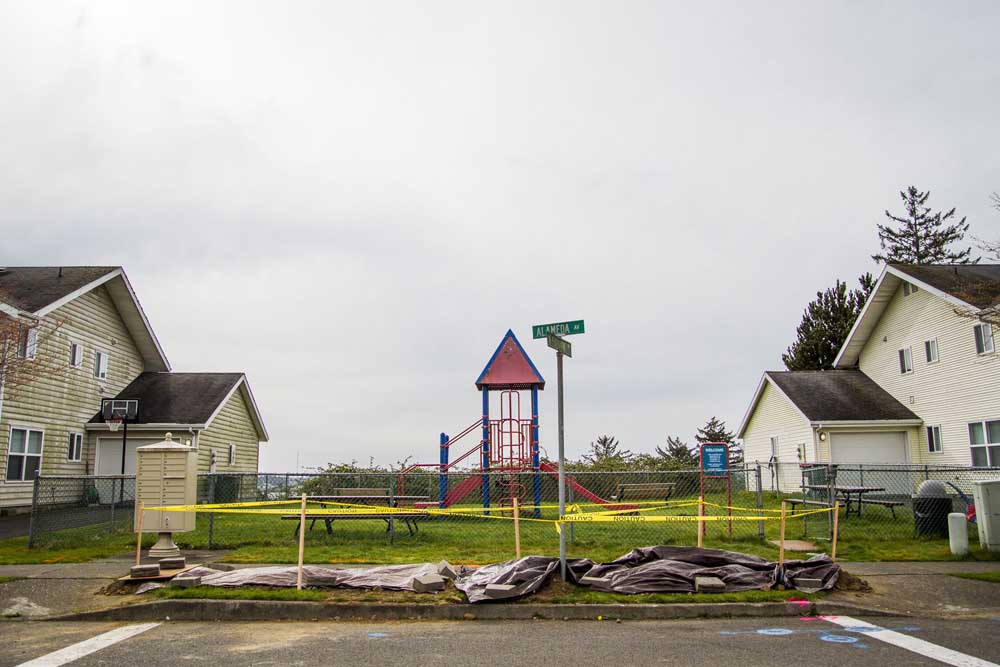Caution: Kids at play
Published 5:28 am Thursday, March 12, 2015

- An area is roped off in front of a playground at the bottom of West Klaskanine Avenue at Alameda Avenue. The Coast Guard is installing safety barriers in front of the playground to prevent cars from crashing into it.
Jessica Jones thinks some drivers who careen down narrow, winding West Klaskanine Avenue in Astoria take sick satisfaction from the radar speed sign installed by the U.S. Coast Guard.
The speed limit is 25 mph, there are two speed humps and there are yellow signs warning of children — even blind and deaf children — at play in the neighborhood, but drivers routinely flout the law.
A similar pattern occurs on nearby Alameda Avenue, where a safety corridor sign has been posted by the Coast Guard, even though, technically, it is not a state safety corridor where traffic fines are double. (There are currently no blind and deaf children, either.)
“People like to see how far they can push it,” said Jones, a mother of two whose husband serves in the Coast Guard. “Everybody likes to push boundaries.”
Fed up, Jones and more than a half dozen others who live in the Coast Guard housing tract have pleaded with the city for help. The women dominated a “Meet the Mayor” event on traffic safety with Mayor Arline LaMear at City Hall earlier this month and are in talks with the city about ideas to calm traffic.
“People want something done,” Jones said. “We’re afraid for our children.”
In hilly Astoria, there are numerous streets and intersections that pose potential traffic hazards. But the West Klaskanine-Alameda junction has a dangerous combination of speed, a steep hill, two playgrounds for children, and a busy school bus stop.
Construction of new Coast Guard housing has only added more peril to the mix from large trucks and equipment.
“I’m afraid to see a child get hit,” said Kelly Shoemaker, a mother of four whose husband is in the Coast Guard. “Little kids, even if you educate them, they don’t always listen. It’s part of being a kid — it’s learning your lessons.
“And I’m afraid that you’re going to turn your back, with the small yards that we have, and one kid’s going to walk out, and then that’s going to be it. Not only will the driver have to live with that, but the parent’s going to have to live with that.
“So it concerns me.”
While it may seem counterintuitive, research shows that radar speed signs and children at play signs may not always reduce speeding and could actually increase risk.
Radar speed signs may temper speeding in the short term, but if the signs are subjectively installed to pacify concerned residents, rather than based on traffic data analysis and matched with law enforcement, drivers may ignore the warnings over time.
The Federal Highway Administration does not sanction children at play signs, which may encourage children to play in the street and make parents less vigilant. The federal government considers the signs unenforceable roadside obstacles for both pedestrians and drivers.
Speed humps can be effective if placed appropriately, traffic researchers believe, although they can slow emergency response times.
After hearing complaints from the Coast Guard families, the city will consider installing two new speed humps on Alameda Avenue to pair with the ones already on West Klaskanine.
The Coast Guard families have suggested portable speed bumps, which would force drivers to slow to a crawl, but the city said speed bumps would potentially disrupt snow plows and delay emergency response.
“We’re going to continue our research, look at what they have in place now, and see if it’s feasible to add the two speed humps to match their existing ones and whether that will improve the condition,” said Jeff Harrington, a city engineer. “And, of course, that will have to be approved by City Council.”
The city doubts engineering alone will solve the speeding problem on West Klaskanine and Alameda, since it is rooted in driver behavior. The city and Astoria Police have urged driver safety education among Coast Guard families and at nearby Astoria High School.
The message for drivers, Harrington said, is basic: “Please slow down.”
The Coast Guard families feel the city has listened to their concerns, but are skeptical about the city’s insistence that additional traffic calming strategies would not work.
Portable speed bumps, one Coast Guard wife said, were effective at deterring speeding drivers in Coast Guard housing near Cape Cod, Mass.
Jones has taken traffic control into her own hands outside her Alameda Avenue home. She regularly places a small, yellow-and-red “Caution: Kids at Play” sign in the street.
“I like to stick it out just enough to disturb traffic,” she said.




